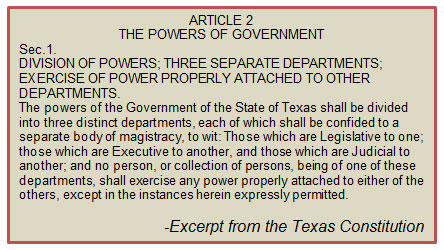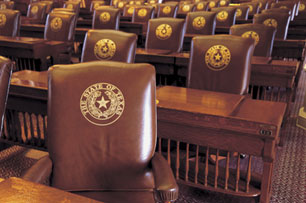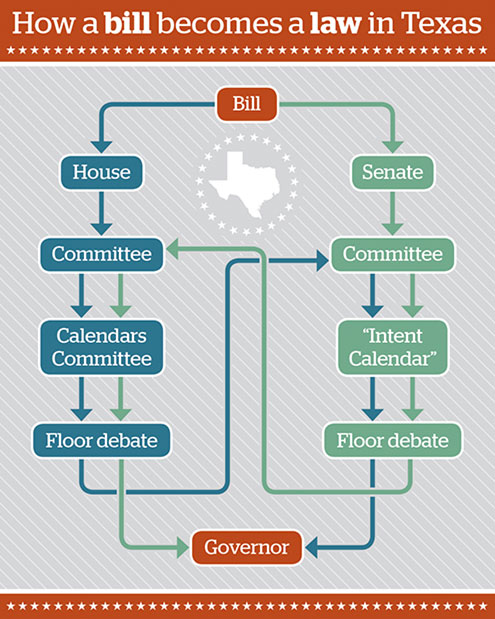
When you think of state government, what comes to mind? Do you think of the state governor, the state troopers, or maybe the state highway department? These are all examples of state government in Texas, but there is so much more to Texas state government.
The state government of Texas is similar to the federal government of the United States. The Texas Constitution and the U.S. Constitution are also similar.

Let’s think about this: Which constitutional principal does the above excerpt represent?

The Texas state government is separated into three branches: legislative, executive, and judicial. Each branch of government has a specific function and purpose.

Source: Seats-close, Texas House of Representative
The legislative branch, also called the Texas Legislature, consists of the Texas House of Representatives and the Texas Senate. Texas is divided into voting districts; all senate districts are equal in population. The house districts, while smaller than those of the senate, are about equal in population. Every ten years, redistricting takes place to adjust for the gain or loss of population.
The Texas Legislature meets during its regular session from January to May lasting no longer than 140 days. The session starts in January of every odd-numbered year. The governor may call a special session for specific reasons; this session is limited to a 30-day session.
There are 150 members of the House of Representatives. Each is elected to a two-year term, and he or she may be re-elected continuously, as there are no term limits.
At the beginning of each session, the members of the Texas House elect a member to serve as the Speaker of the House. The Speaker presides over the Texas House of Representatives.
What do you think are the qualifications to become a member of the House of Representatives?
The following are the qualifications for a member of the Texas House of Representatives:
–Adapted from Texas Constitution, Article 3, Section 7

Find your current Texas Representative by entering your address, including the city and zip code.

Source: Seal, Texas State Senate
There are 31 members in the Texas Senate. Each senator is elected to a four-year term. There are no term limits for the reelection of Texas Senators. The Lieutenant Governor, an elected official, presides over the Texas Senate. Although the lieutenant governor is not an official member of the Texas Senate, his or her main function is to vote in the case of a tie. The lieutenant governor appoints the member of Senate committees.
Click here to see a floor chart of the 83rd Legislature Texas Senate (2013).
What do you think are the qualifications to become a member of the Texas Senate?
The following are the qualifications for a member of the Texas Senate:
–Adapted from Texas Constitution, Article 3, Section 6

One of the main functions of the legislative branch is to create laws. The Texas Legislature creates laws that impact the lives of Texans. The laws relate to a myriad of issues, including taxes, public education, and healthcare.

Source: House-floor, Texas House of Representatives
The image below demonstrates how bills become laws in the Texas Legislature.

Source: Diagram, Bill Becomes Law, Impact News
For a more detailed diagram, click on the link below.
Diagram of Legislative Process
The executive branch in Texas state government involves the governor, other officials, and specific agencies. Much like the president of the United States, the governor of Texas is the chief executive of the state of Texas. The governor is elected statewide for a four-year term. The citizens of Texas elect him or her every four years.

Source: TexasGovernorRickPerry, Office of the Governor
What do you think are the qualifications to become a Texas governor?
The following are the qualifications for governor of Texas:
–Adapted from Texas Constitution, Article 4, Section 4

There are some duties that the governor must carry out during his or her term. One of the governor’s main duties is to appoint members to various boards and commissions, which cover policies on various issues. The governor also appoints people to lead certain agencies in the executive branch. Some of these appointed positions include the secretary of state and the labor commissioner. Read a partial list of these duties below.
The following are some of the duties of a governor:
–Adapted from Governor’s Duties, Requirements, and Powers-
Office of The Governor Rick Perry
The lieutenant governor is an elected official who serves as a replacement for the governor during his or her absence. The lieutenant governor serves as the president of the Senate. The voters of Texas elect the lieutenant governor. He or she has a considerable amount of power in the Texas Senate.
There are other elected officials in the executive branch. These officials lead some of the most important agencies within the executive branch. These elected officials include the following:
Collectively, the purpose of the executive branch is to enforce the laws of the state. The governor, the elected and appointed officials, and agencies in this branch are responsible for carrying out the laws.
The judicial branch of the Texas state government is made up of the court system that starts at the municipal level and ends at the highest state appellate courts.
![]() Click on each segment of the diagram below to learn more about the court system of Texas.
Click on each segment of the diagram below to learn more about the court system of Texas.
The success of the Texas court system involves the work of various Texas citizens. Citizens elect judges in Texas courts. The judges, who lead the courts, work with law enforcement officers, attorneys, and juries to conduct the business of the courts.
Click on the link below to see a more detailed diagram of the Texas court system.
Court Structure of Texas
The three branches of Texas state government are vital in keeping Texans safe and help the day-to-day function of the state. The work of the people involved is important, but it also takes money for the state to function. Annually, Texas government develops a budget that is created by the Legislative Budget Board. The sales tax is the main source of income for the state, but there are also other sources of revenue that fund the state’s operation. This budget is also funded by the various fees, licenses, and permits that the state collects.
The state also receives a large source of revenue from the federal government. There are nearly 100 federal funding sources in Texas, including health and housing programs, transportation, and programs for the poor and disabled.
![]() In the following activity, read the statements related to the legislative, executive, and judicial branches of state government. Determine which branch the statement relates to, and click on the correct branch.
In the following activity, read the statements related to the legislative, executive, and judicial branches of state government. Determine which branch the statement relates to, and click on the correct branch.